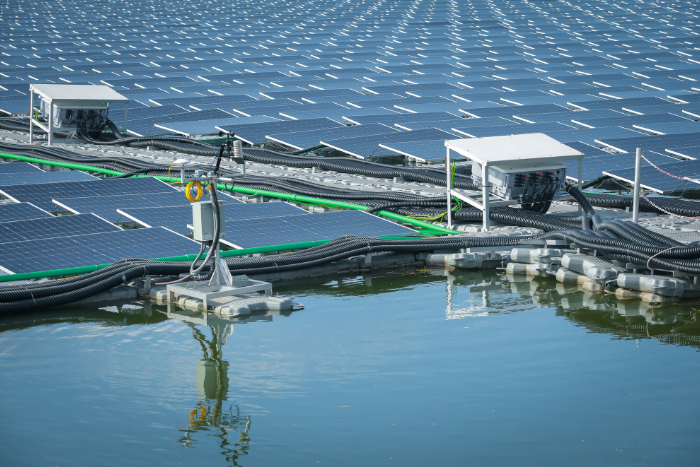Water bodies in India have the technical potential to host 206.7 GW of floating solar capacity, according to an assessment prepared under the Indo-German Technical Cooperation on Innovative Solar (IN Solar). The study used GIS-based data for all bodies of water in India by referencing the Copernicus Programme by the European Commission.
The data set was filtered to include bodies of water with a usable area greater than 0.015 sq km, with 12 months of water availability, while excluding bodies of water in protected zones. An area of 0.015 sq km is required to install 1 MW of floating PV.
The state of Madhya Pradesh has the maximum potential of 40,117 MWp, followed by Maharashtra with 32,076 MWp.
Biden hikes import duties on Chinese EVs from 25% to over 100%, but ‘wont impact China’
The Biden administration is set to announce that it “plans to raise tariffs on Chinese electric vehicle [EVs] imports from 25% to 100%” alongside tariffs on solar products and other clean-energy products. But a Bloomberg report said Biden may quadruple tariffs to 102%, while another stated the move is “mostly symbolic” as Chinese manufacturers are “not reliant on US consumers”.
Xinhua reported that China’s “new energy vehicles” (NEV) production in April totalled 870,000 units, up 35.9% year-on-year, while sales reached 850,000 units, up 33.5%, according to data released by the China Association of Automobile Manufacturers (CAAM).
Rajasthan Invites Bids to Develop 8 GW Solar Projects
The Rajasthan government invited bids to set up 8,000 MW solar power projects in the state. Bidders must submit ₹29,500 as the cost of the document fee and ₹500,000 (~$5,996) + 18% GST as the bid processing fee, Mercom reported, adding that bidders must also furnish an earnest money deposit (EMD) of ₹500,000/MW of the quoted capacity. The outlet said selected bidders must provide a performance bank guarantee of ₹1.2 million (~$14,388)/MW per project at least seven working days before signing the PPA.
The developer’s responsibilities include identifying land, installing and owning the project, and obtaining connectivity, approvals, and interconnection with the STU network.
Bidders must submit a single bid offering a minimum contracted capacity of 4,000 MW in the specified formats, the state norms said, adding that the modules used in the project must be from the latest Approved List of Models and Manufacturers issued by the Ministry of New and Renewable Energy.
Tata eyes rooftop solar subsidy scheme as a billion dollar chance
The Centre’s rooftop solar subsidy scheme for households is a $1 billion-plus business opportunity for Tata Power over the coming three years, as the company looks to corner a fifth of the domestic market for solar modules, the company’s managing director Praveer Sinha said. Tata is eyeing the Prime Minister Surya Ghar scheme, which has target of about 1 crore homes. Tata expects the scheme to generate demand for 25-30 GW of solar modules over its duration. Tata Power wants to cater to 5-6 GW of this demand, he said.
At an estimated price of 20 cents per watt, according to Sinha, this could translate to a business opportunity of $1-1.2 billion ( ₹8,350 crore-₹10,000 crore).
Sinha, who said Tata Power holds 13% of the domestic solar module market, wants to ramp up its share to 20% on the back of its new solar cell and module manufacturing unit in Tamil Nadu.
Solar firms win court case for duty-free imports
In a major win, the Delhi high court ruled in favour of the solar sector dismissing attempts by the revenue department to deny duty-free imports to solar power projects set up in warehouses, reported TOI. The report said the decision brings clarity to the application of the Manufacture and Other Operations in Warehouse (MOOWR) regulations.
Solar power companies filed petitions challenging an instruction issued by the Central Board of Indirect Taxes and Customs (CBIC), which aimed to restrict the use of bonded warehouses for solar power projects. The CBIC contended that the regulations were designed to defer Customs duty and Goods and Services Tax (GST) on goods used in manufacturing processes within warehouses and not imported capital goods. The judgment stated that Section 65 of the Customs Act does not preclude solar power generation from its purview. The regulations under this section were intended to promote various operations, including the use of capital goods in bonded warehouses.
The court declared the CBIC’s instruction invalid, as it imposed constraints not supported by the statutory framework. It emphasized that administrative instructions cannot override legislative provisions or judicially approved licenses. The court highlighted that the statutory position allows for the warehousing of capital goods, including those used in solar power projects.
US approves rule to expand transmission of renewable power
Two years after it was kept under development, the US Federal Electricity Regulatory Commission (FERC) approved a rule to make it easier to transmit renewable energy such as wind and solar power to the electric grid. The Associated Press report said the 1,300-page rule, on transmission grid planning and cost allocation, aims to boost grid resilience to extreme weather, cope with rising demand and accelerate construction of new lines.
Under the new norms, grid operators around the country will have to identify needs 20 years into the future, taking into account factors like changes in the energy mix, the growing number of states that require wind and solar power and the risks of extreme weather, explained the NYT. Grid planners would have to evaluate the benefits of new transmission lines, such as whether they would lower electricity costs or reduce the risk of blackouts, and develop methods for splitting the costs of those lines among customers and businesses, said the newspaper.
About The Author
You may also like
Non-Fossil Fuels Generates One-Third of India’s Electricity in 2025
India on track to achieve 2030 clean energy target
India to add 45GW solar capacity in FY 2026: Study
Government Proposes for ALMM Expansion for Solar Backward Integration
China’s renewable energy expansion can fuel global energy transition: Report

